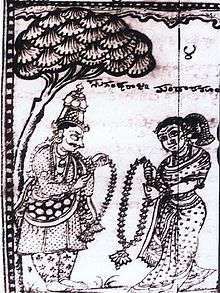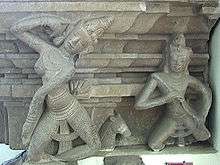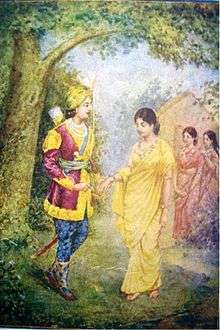Gandharva marriage
A Gandharva marriage (Sanskrit: गन्धर्व विवाह, pronounced gənd̪ʱərvə vɪvaːhə) (known as love marriage) is one of the eight classical types of Hindu marriage. This ancient marriage tradition from the Indian subcontinent was based on mutual attraction between two people, with no rituals, witnesses or family participation.[1] The marriage of Dushyanta and Shakuntala was a historically celebrated example of this class of marriage.[2]
Etymology
In Hinduism and Buddhism, Gandharvas are male nature spirits and the feminine counterparts of the Apsaras. They are passionate lovers of women and arouse erotic and romantic passion in women.[1]
History
The Smritis of Hinduism recognize eight methods of marriage, one of them being Gandharva marriage. The other seven are: Brahma, Daiva, Arya, Prajapatya, Asura, Raksasa and Paisacha.[5][6]
According to Apastamba Grhyasutra, an ancient Hindu literature, Gandharva marriage is a method of marriage where the woman chooses her own husband. They meet each other of their own accord, consent to live together, and their relationship is consummated in copulation born of passion. This form of marriage did not require consent of parents or anyone else. According to Vedic texts, this is one of earliest and common forms of marriage in Rig Vedic times.[6]
In Rig vedic opinions and classical literature, the commonly described marriage method was Gandharva, where the bride and the groom had met each other in their ordinary village life, or in various other places such as regional festivals and fairs, begun to enjoy each other's company, and decided to be together. This free choice and mutual attraction were generally approved by their kinsmen. A passage in the Atharvaveda suggests that parents usually left the daughter free in selection of her lover and directly encouraged her in being forward in love-affairs. The mother of the girl thought of the time when the daughter's developed youth (Pativedanam, post-puberty), that she would win a husband for herself, it was a smooth and happy sort of affair with nothing scandalous and unnatural about it.[7][8] The translated version of the Atharvaveda (Strikaratâni, ii.36) passage is:
May (Oh Agni!) a suitor after our own heart come to us;
may he come to this maiden with fortune;
May she be agreeable to suitors,
charming at festivals,
promptly obtain happiness through a husband.
As this comfortable cave (Oh Indra!) furnishing a safe abode
hath become pleasing to all life,
thus may this woman be a favourite of fortune,
well beloved,
not at odds with her husband!
Do thou ascend the full, inexhaustible ship of fortune
to bring hither to this woman the suitor who shall be agreeable to thee.
Bring hither by thy shouts (Oh lord of wealth!) the suitor –
bend his mind towards her.
Turn thou the attention of every agreeable suitor to her.
In Mahabharata, one of two major epics of Hindus, Rishi Kanva, the foster father of Shakuntala, recommends Gandharva marriage with the statement “The marriage of a desiring woman with a desiring man, without religious ceremonies, is the best marriage.”[9] Elsewhere in Mahabharata (iii:190.36), the epic says “No man any longer asks for the daughter, nor does a father give away his daughter, they (women) find the man for themselves.”[10]
Historic debate
Gandharva marriage over time became controversial, disputed and debated. Majority of ancient scholars discouraged it on religious and moral grounds.[11] One argument found in the classical literature is that Gandharva marriage originates and sustains from lust, ignores the sacred rituals and vows the groom and bride must make to each other, and it does not consider other aspects of a relationship necessary in a long married life that lasts through the old age. Such a marriage, argued these ancient vedic scholars, may or may not be lasting.
Manu argued that Gandharva marriage may be suited for some, but not for most; he argues Gandharva marriage is best suited for males who are warriors, serving in the military, administrators, nobility and rulers (Kshatriyas).[12] Baudhayana, another ancient vedic scholar, disagrees and writes Gandharva marriage is suitable for most people including merchants and farmers and artisans (Kshatriyas, Vaishyas and Shudras), but not for the priest families (Brahmin castes). Baudhayana claims that this is so because Gandharva marriage is based on love and free will. Narada, yet another ancient scholar who wrote Nāradasmṛti sometime between 100 BC and 400 AD, suggests Gandharva marriage is best for everyone including the Brahmins, calling it sadharna; Narada claims the only methods of marriage that are wrong are those that are based on abduction, violence, fraud or purchase.[12][13]
Decline

There is no consensus theory to explain why Gandharva marriages declined. One theory claims that as prosperity and wealth increased, parents sought greater control of the activities and social life of their children. Another theory claims that after the vedic period when marriageable age for girls was 16 years or higher, social upheavals encouraged child marriages. The social upheavals included those caused by wars between Indian kingdoms, unexpected attacks and attempts to take young women and men as prisoners during waves of attacks from Persia, central Asia and Muslim Sultans/Emperors. With the arrival of Muslim culture and rulers, which itself favored child marriages, the Hindu culture too shifted to child marriages where the girl was not mature. This practice eliminated the girl's desire or ability to seek men on her accord, meet them, choose and enter into Gandharva marriage.[14][15] In addition to the influence of foreign conquest, claims Pandey, Hindu ideology shifted from diversity of marriage types to where the social pressures compelled the girl's family to seek arranged early marriages. Yet another theory is that the priestly caste of India, who officiated Brahma marriages and religious ceremonies, over time crafted rules that declared Gandharva marriage for most Hindus as inappropriate and disapproved (aprasasta), because traditional marriages were a source of their income, and Gandharva marriages made them poorer or obsolete.[16]
Indian courts' perspective
In 1817 AD, Gandharva marriages in India were ruled legal for some social groups by the Bengal Saddar Court.[17]
In 1930, Justice Abdur Rahim held that the marriage in Gandharva form was not valid in India. This ruling came from the Madras High Court, with the statement that amongst the Hindus, the Gandharva form of marriage was obsolete (as of 1930). This was appealed with the note that the fact that the case is in court is proof that Gandharva weddings among Hindus is not obsolete.[18]
In 1946, the Patna High Court in Kamani Devi v. Kameshwar Singh, ILR 25 Pat 58 = (AIR 1946 Pat 316) held that the relationship of husband and wife, created by Gandharva marriage is binding. The husband, the court ruled, cannot escape his responsiability of financially caring for his wife married in Gandharva form. The Patna High Court went further and held that the celebration of Gandharva form of marriage must be attended with nuptial rites and ceremonies including Homa (invocation before the sacred fire) and Saptapadi (the taking of seven steps by the groom and the bride together) for its validity. This ruling was cited in a decision by the Supreme Court in the case of Bhaurao v. State of Maharashtra.
In a 1974 case, Justice Mukherji noted, "Gandharva form of marriage should not be regarded as concubinage or quasi-marital union, more so in the context of the modern Society and in the background of the forward thinking of the present law givers. The possibility of legal validity of this form of marriage in the whole of India in near future even without being backed by custom, is too notorious to be ignored. In a sense, Gandharva form of marriage is trying to come back very fast (in India), pushing parental domination to the background."[18]
Reemergence
In modern India, particularly in urban regions, Gandharva marriage is re-emerging. One term for couples choosing their own partners is 'love marriage' in India which usually means a couple choosing each other of their own accord but in most cases following it up with Hindu rituals.[19][20][21] However, to that extent 'love marriages' do not fulfill the criterion of Gandharva marriage but the English term 'live-in relationship' arrives at the closest co-relate wherein the parents', state's and religion's word is irrelevant.[22]
References
- Catherine Benton, God of Desire: Tales of Kamadeva in Sanskrit Story Literature, SUNY Press, 2006, ISBN 978-0-7914-6566-0,
... male counterparts of apsaras, gandharvas are known to love women; and women fall instantly for the charms of gandharva men ... awaken sexual passion in women ... In a gandharva marriage, a man and woman are so drawn to one another in mutual passion that they run off together without ceremony or consent of their families ...
- Johann Jakob Meyer, Sexual life in ancient India: a study in the comparative history of Indian culture, Motilal Banarsidass Publishers, 1989, ISBN 978-81-208-0638-2,
... Gandharva marriage, which is also part of the orthodox system ... Dushyanta. This king's Gandharva marriage with Cakuntala, which is well-known especially through Kalidasa's drama, is a celebrated example ... only for warrior nobility according likewise to Manu ... Narada states without hesitation that this kind of marriage belongs to all castes alike ... 'survival from the time of promiscuity'; might well be understood from an "inter-ethnic" standpoint ...
- The Illustrated Encyclopedia of Hinduism: A-M, James G. Lochtefeld (2001), ISBN 978-0823931798, see pages 102-103
- Shakuntala: An Indian Love Story Makarand Paranjape, University of Saarland, Germany (2010)
- The Illustrated Encyclopedia of Hinduism: A-M, James G. Lochtefeld (2001), ISBN 978-0823931798, Page 427
- Hindu Saṁskāras: Socio-religious Study of the Hindu Sacraments, Rajbali Pandey (1969), see Chapter VIII, ISBN 978-8120803961, pages 153-233
- Hindu Saṁskāras: Socio-religious Study of the Hindu Sacraments, Rajbali Pandey (1969), see Chapter VIII, ISBN 978-8120803961, pages 162
- Johann Jakob Meyer, Sexual life in ancient India: a study in the comparative history of Indian culture, Motilal Banarsidass Publishers, 1989, ISBN 978-81-208-0638-2
- See Mahabharata, iv, 94.60, as translated by Rajbali Pandey (1969)
- Johann Jakob Meyer, Sexual life in ancient India: a study in the comparative history of Indian culture, Motilal Banarsidass Publishers, 1989, p. 89, ISBN 978-81-208-0638-2
- Hindu Saṁskāras: Socio-religious Study of the Hindu Sacraments, Rajbali Pandey (1969), see Chapter VIII, ISBN 978-8120803961, see page 163
- Johann Jakob Meyer, Sexual life in ancient India: a study in the comparative history of Indian culture, Motilal Banarsidass Publishers, 1989, p. 90, ISBN 978-81-208-0638-2
- Nāradasmṛti xii.44
- Hindu Saṁskāras: Socio-religious Study of the Hindu Sacraments, Rajbali Pandey (1969), see Chapter VIII, ISBN 978-8120803961, see pages 163-189
- Kamasutra Of Vatsayana - Richard F. Burton, Penguin Books; ISBN 9780143066446; see pages 48-51 (Review and Introduction by John Spellman, 1962)
- Johann Jakob Meyer, Sexual life in ancient India: a study in the comparative history of Indian culture, Motilal Banarsidass Publishers, 1989, pp. 94–97, ISBN 978-81-208-0638-2
- John Dawson Mayne, A treatise on Hindu law and usage, Higginbotham, 1878,
... The validity of a Gandharva marriage between Kshatriyas appears to have been declared by the Bengal Sudder Court in 1817 ...
- Ram Chandra Bhattacharjee vs Manju Bhattacharjee on 17 September, 1974, AIR 1975 Cal 118, Judge N.C. Mukherji (Calcutta High Court)
- Love marriage and Indian Society, Zara (July 2013)
- Gupta, Giri Raj. "Gupta, G. R. (1976). Love, arranged marriage, and the Indian social structure. Journal of Comparative Family Studies, 7(1), pages 75-85
- "One of USA's exports: Love, American style". USA Today. 13 February 2006.
- Anand, Ankita; Anand, Ankita. "The complete guide to live-in relationships in India". Quartz India. Retrieved 2019-05-23.

